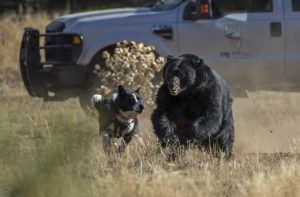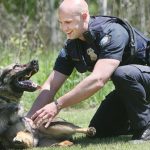Bear Dogs
September 10, 2020

Lake Tahoe promises a few things: falling snow, tall trees, breathtaking views and bears.
Living in the Tahoe Basin comes with responsibility. Residents must understand the surrounding wildlife and do their part to remove attractants and properly manage trash. As more people come to Tahoe, more conflicts arise with residential communities.
Last summer a beloved and known Tahoe Vista bear was killed in North Lake Tahoe by a homeowner. The bear was reportedly killed after breaking into the car of a homeowner in search of food. The homeowner obtained a license to trap and kill the bear through the California Department of Fish and Wildlife.
For wildlife that become too habitualized with people, it can be a death sentence.
Residents and wildlife advocates have urged for nonlethal methods to resolve conflicts and pressured agencies to adopt the same, such as rubber shotgun bullets and noise makers.
Nevada Department Of Wildlife adopted a program in the early 1990s that has since been gaining popularity called the Karelian Bear Dog Program.
The program involves the use of Karelian Bear Dogs to haze wildlife away from property in human-wildlife conflict situations by creating an unpleasant experience for the bears known as aversive conditioning.
This rare, specific breed of dog originated from a place between Finland and Russia called Karelia. The dogs were originally used to seek out big game for hunting. Unlike their lookalike, the Border Collie, these dogs have a primitive demeanor and are far from the “typical” dog.
Karelian Bear Dogs have been used to minimize conflicts in Washington, Nevada, California and other countries such as Japan and Canada.
The purpose of the program is to teach bears to be wary of humans. The dogs are trained to create an unpleasant experience for the bear by nipping and incessant barking. When the dogs chase the bears it gives the bear a feeling of pursuit that relates back to primal dominance according to Nevada Department of Wildlife’s website. Rich Beausoleil, Bear and Cougar Specialist of Washington Department of Wildlife has two Karelian Bear Dogs; Cash and Indy. Beausoleil said that he first got involved in the program in 2003 because he wanted a more self-sufficient way to conduct research captures of bear and mountain lions for radio collar and population estimation work. He also said he wanted a better way to address human-wildlife conflicts.
Beausoleil said that killing and relocating does not solve the problem.“It’s merely putting a Band-Aid on a bullet hole. It’s about getting people to listen and understand why the animal was there in the first place.”
Washington state has used Karelians for research captures, finding injured or orphaned wildlife, outreach events and human conflict resolution. “We’ve saved over 80 orphaned mountain lions and over 150 bears, not all, but the majority with KBDs,” said Beausoleil. “One [KBD] even found a missing person where authorities suspected foul play – turned out he was killed in a rock slide and was underneath the slide.” California Department of Wildlife’s bear biologist Mario Klip also has seen success with KBDs. Klip, who owns KBDs, says that it is a lifestyle you must be comfortable with.
Klip conducted a research study for UC Berkeley where he observed spatial and temporal patterns of American black bears in the Tahoe Basin and found that aversive conditioning using Karelians can help a conflict temporarily and meets the communities’ expectations.
According to Klip’s study, “Besides short term gains, KBDs have impacts on bear behavior that makes bears less inclined to interact with people in the first place.” The study indicates that it might be more challenging to find dedicated biologists or wildlife managers who are willing to take care of the dogs after retiring from active bear duty.” Klip notes that KBDs are a beneficial tool when the dogs are partnered with an active bear manager or biologist for mitigating urban bear-human conflicts. The study stated “use of aversive conditioning by dogs adds significant synergistic effects to traditional approaches for addressing human-wildlife conflict.”
However, the program still doesn’t fix the root problem.
“It’s painfully obvious that this is about people management and not a bear or cougar concern or population increase,” says Beausoleil. “Anything we do with dogs is temporary — we aren’t teaching bears or anything else to avoid people. It’s a temporary diversion so you can address the attractants … and get people to change.”
The Karelian Bear Dog Program has been used in the Sierra Nevada to haze bears away from specific locations. The Bear League is a nonprofit that is committed to protecting bears in their natural habitat using education, aversion and by responding to conflicts.
“We tried to use them in conflict areas in a community, it doesn’t work well,” says Ann Bryant of Bear League, who lives in Homewood on Lake Tahoe’s West Shore.
Bryant trained two KBDs 15 years ago in hopes of using them to help mitigate the human-bear conflict.
“Bears can’t just run around in neighborhoods with dogs chasing them,” Bryant said. “In areas like Tahoe, dogs could run a bear into a major road. It is a false panacea.”
In Tahoe, human-bear conflicts come from bears getting into trash and damaging property which can constitute for a bear getting killed.
“Karelians can work well if in a big rural area, campground, grazing land … areas like that,” said Bryant. She said that this program would work in the perfect scenario but Tahoe’s landscape does not allow that. “In an appropriate place and if they are well trained, well cared for … they can be valuable and serve a purpose. This is not going to work here with the amount of people that we have,” said Bryant. In 2019, NDOW’s bear mortality rates were reduced while 2018 had the highest rate in the previous four years even when the program was in place.
NDOW declined to talk to Tahoe Magazine about the program. Carrie Hunt and the Wind River Bear Institute have had great success with their “Wildlife K-9” (WK9) programs that have span throughout western North America and Japan.
Hunt, bear biologist in Florence, Montana founded the Wind River Bear Institute which is dedicated to reducing human caused bear mortality.
The Institute has used KBD’s with black bears, grizzly bears, polar bears, cougar, moose and big-horned sheep. Her innovative approach has helped pose non-lethal solutions to wildlife conflicts.
Nils Pedersen, bear biologist and director at the Wind River Bear Institute lives in Fairbanks, Alaska. Pedersen started by training WK9s at the institute. His first winter in the field, he helped train WK9s for polar bear den detection in the Arctic.
With a mission to avoid den abandonment and mortality, Pedersen has worked with WK9s to survey and detect denned bears to prevent them from being disturbed by industrial activity.
“These dogs are uniquely fit for this kind of job,” Pedersen said.
Every dog has a purpose that comes from Wind River Bear Institute, which along with Glacier National Park trained the first National Park Service WK9, a Border Collie/Australian shepherd cross named “Gracie.” Gracie’s job is to shepherd big horn sheep and deer away from places where humans are.
“These dogs have done important work at every major national park in the west,” Pedersen said.
“The difference between KBDs and other breeds of hunting dog is that the KBD can safely and effectively dance with a grizzly bear on the ground and hold the bear at bay.”
The institute has been working for 25 years and have never had a major injury to a dog, person or bear.
Pedersen said that determining when the use of WK9s is appropriate is absolutely key.
The dogs may not be appropriate in all settings.
“Bears are trainable and can understand lessons,” he said. “For instance, they can understand that one area is unpleasant. Our WK9s are highly trained and very well socialized with people.”
A huge part of the program is training and testing the dogs. WRBI does comprehensive working aptitude and personality testing to determine the environment the specific KBD would do best.
Only 20-40% of KBDs from good working lines actually end up being fit in the testing process for bear-conflict work and WK9 certification. Bear conflict dogs would be extremely difficult pets making them only suitable in a human-wildlife conflict realm.
Using the dogs in an urban setting is not as simple as just letting the dogs loose on an animal.
On-leash work is almost always deployed in an urban setting. Pedersen says that there are only really a few circumstances of off-leash work. The picture in your head of the dogs chasing the bears away through the forest is not completely accurate.
A well trained KBD will try to draw the bear away from their handler and hold it at bay. Pedersen explains that the most challenging part of solving human-bear conflict issues boils down to managing people. “Bears are remarkable at coexistence,” he says. “Sometimes we will just monitor the bear or close down a particular area of the park to prevent conflict.”
John Griffin, Senior Director of Urban Wildlife Program for the Humane Society of the United States said that human-wildlife conflicts will continue to rise and the program is useful for teaching both bears and people while raising public awareness.
“All of these programs need to be tailored to the specific bear country,” says Griffin.
Pedersen made it clear that he and the institute does not promote the breed.
“We place the right dog with the right person in the right place,” he says. The WRBI is very selective with whom they place their dogs with.
They see the tragic implications of when KBDs get placed in the wrong hands. These dogs aren’t like the typical golden retriever. They were bred to leave you. The dogs are primitive and have an innate instinct to hunt.
“Some breeders do it irresponsibly and are exploiting the dogs’ popularity,” Pederson said.
He explained how WRBI’s process is extremely selective and there are breeders who don’t respect the nature of these dogs and don’t properly educate people on the breed.
Irresponsible breeders are using the increasing popularity to market these dogs as hunting dogs or protection dogs for the general public.
“There are breeders sellings KBDs to people who have no place in owning one of these dogs,” said Pedersen.
Pedersen explained that if KBDs are not trained and socialized they can become a nuisance and harass livestock, kill wildlife and end up in a dog pound. “The dogs are time and resource intensive.”
Beausoleil said, “There are no Sunday walks — they’re all hunts so it’s much more involved than having a pet dog. Too many people get Karelian Bear Dogs because they think they’re cool and then realize they are hard to own because they have to exercise, and work, and hunt. On days I don’t work, it’s 5 miles of walking in the morning and 5 miles in the evenings. No exceptions.” These unique dogs need vigorous exercise, time and constant stimulation.
“People are getting excited to get these dogs as a solution to human-bear conflicts only to realize that they are extremely difficult to care for. KBDs are being killed or returned to shelters,” says Bryant. “The downfall of these dogs are that they are not cuddly lap dogs, they are very primitive, wild. They think differently, not like a traditional house pet. That same reason is why they are used. They are fearless. There have been reports of them attacking children.”
These dogs are meant to have a human companion with a similar mission and enthusiasm.
SOLVING THE MAIN PROBLEM
These dogs can be an important tool for wildlife conservation in certain locations and can be a great outreach tool to get the community involved in doing their part in reducing conflicts.
Pedersen says that the dogs can be used to get the dialogue started and a message remembered. He says, the dogs act as “wildlife ambassadors”, providing an opportunity to talk to people about bear safety and attractants. “Dogs appeal to people in a memorable way. They help get the science out there.” People are more likely to remember a wildlife conservation message and connect with it through the use of working dogs.
The WRBI wants people to understand that bears deserve our respect and that it is a shame that bears are killed for reasons that are entirely preventable. Pedersen said, “Bears aren’t often represented accurately in the media.”
“It is challenging because there are a lot of people with a lot of garbage,” Pedersen says.
The number one problem contributing to bear conflicts is garbage.
Pedersen says that real solutions need to come from combating the major trash problem by talking to waste management, passing and enforcing ordinances along with installing bear proof garbage containers.
“It can become political.”
Pedersen said, “The solution to human-bear conflict issues is not a KBD in everybody’s home, we need to secure garbage and other attractants so we aren’t actively baiting bears into human occupied space. The KBD is a bear management tool to reduce the need for lethal removal and relocation of bear and other large and potentially dangerous wildlife, but the dogs won’t be effective if people don’t play their part in preventing bear access to food-garbage.”













